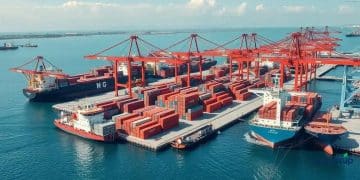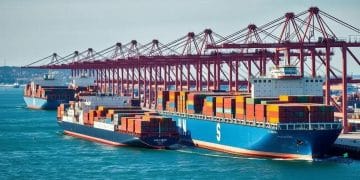Trump trade war escalation: what you need to know

The Trump trade war escalation involves tariffs imposed by the U.S. on imports to protect domestic industries, significantly affecting global trade relations, pricing, and economic strategies for businesses and countries alike.
In recent times, the Trump trade war escalation has captured headlines and caught many by surprise. This ongoing conflict could significantly shape the economic landscape.
Are you prepared for the potential ripple effects on your daily life?
Background of the Trump trade war
The background of the Trump trade war is critical to understanding its impacts. It all began in 2018 when President Trump imposed tariffs on imported steel and aluminum. This move aimed to protect American industries, but it quickly escalated into broader trade tensions with major trading partners.
As the situation developed, various countries retaliated, leading to a series of tariff increases.
The goal was to pressure other nations into changing their trade practices, especially China. The tension was palpable as industries braced for a potential economic shakeup.
Key Events in the Trade War
Several key events marked the escalation of this trade conflict:
- The initial tariff announcements set the tone for confrontations.
- China’s retaliatory tariffs on U.S. goods targeted agricultural sectors.
- Negotiations frequently stalled, intensifying the war.
These events created a feedback loop, impacting various sectors. Businesses faced uncertainty, and consumers began to notice rising prices on imported goods.
The government aimed to protect jobs, but many sectors feared the long-term consequences.
Implications for Global Markets
The effects didn’t stop at U.S. borders. Countries worldwide reacted to the uncertainty, recalibrating trade relationships. As tariffs continued to rise, supply chains adjusted to new realities.
Foreign investment slowed as businesses weighed the risks of escalating costs. For example, technology sectors faced disruptions in sourcing components. The Trump trade war reshaped the landscape, prompting companies to rethink their strategies and adapt to the ongoing changes.
Key countries affected by the escalation

The key countries affected by the escalation of the trade war are more than just economic players; they are intricately linked through trade agreements and markets. As tariffs and restrictions went into effect, the impact rippled across the globe.
China stands out as the most affected country, as it faced significant tariffs on its exports. American goods became more expensive in China, leading to a sharp decrease in demand. This reality forced many Chinese companies to adapt quickly to the changing environment.
Other Major Players
Besides China, several other countries felt the pressure:
- Canada, with its close ties to the U.S., faced retaliatory tariffs on its goods, impacting industries like lumber.
- Mexico also experienced shifts as it became a central focus during negotiations, especially regarding automotive tariffs.
- The European Union grappled with its own set of challenges, attempting to protect its interests while responding to U.S. policies.
Each of these nations took measures to mitigate the effects. For instance, China sought to diversify its markets, while Canada worked to strengthen trade relations with Europe and Asia. Meanwhile, Mexico focused on maintaining its position as a viable supplier to the U.S.
Global Economic Impact
The escalation of the trade war led to a tense global economic environment. Businesses within these countries faced uncertainty, as fluctuations in tariffs affected pricing and demand. Many companies had to rethink their supply chains to manage risks and costs effectively.
Moreover, international relations became strained during this period. As nations adjusted their strategies, geopolitical dynamics shifted. This ongoing situation reminds us of how interconnected modern economies are and how quickly they can change.
Economic implications for the US
The economic implications for the US due to the trade war escalation are significant and complex. As tariffs increased, the immediate goal was to protect American industries. However, this action resulted in a range of unforeseen consequences.
One of the most notable effects has been the impact on prices. As tariffs were applied on imported goods, American consumers saw rising prices in stores. Many common items became more expensive, affecting household budgets across the country.
Industry-Specific Effects
Different industries responded to these changes in various ways:
- Manufacturing faced challenges as costs for materials increased, leading to reduced profitability.
- Agriculture suffered significantly, with farmers losing access to key export markets, particularly in Asia.
- Retail struggled to keep prices competitive while facing higher costs for imported products.
These shifts highlighted how interconnected the economy is. Rising costs not only affected businesses but also created a ripple effect throughout communities. Trust in the market began to wane as uncertainty grew.
Job Market Fluctuations
The trade war also influenced job markets. While some sectors saw job growth due to protectionist policies, others faced layoffs and hiring freezes. In industries reliant on exports, companies had to adapt quickly, leading to instability in employment.
Workers in affected fields often had to seek employment elsewhere, which increased competition for jobs in different sectors. The landscape of American employment began to change as people searched for new opportunities amidst the economic turbulence.
Strategies for businesses to adapt

Businesses facing the challenges of the trade war escalation must adopt effective strategies to adapt and thrive. The economic landscape is rapidly changing, requiring innovative approaches to maintain competitiveness.
First, companies need to assess their supply chains carefully. Understanding where products come from and where potential disruptions might occur can help businesses mitigate risks. Diversifying suppliers is a crucial step to ensure that they are not overly reliant on any single source.
Investing in Technology
Another important strategy is to invest in technology. Automation and data analysis tools can streamline operations, reduce costs, and enhance productivity. By using advanced forecasting tools, businesses can prepare for price fluctuations and demand changes.
- Automation of production lines can improve efficiency and cut costs.
- Data analytics provide insights into market trends and consumer behavior.
- Integration of e-commerce can open new revenue streams.
These technological investments not only help in immediate adaptations but also position businesses for long-term growth.
Building Stronger Customer Relationships
Furthermore, fostering strong relationships with customers is vital during uncertain times. Honest communication about challenges can build trust and loyalty. Engaging with customers through various channels allows businesses to gather feedback, adapt offerings, and enhance customer satisfaction.
Additionally, businesses might explore alternative markets. Expanding into regions less affected by tariffs can diversify risk and create new opportunities for growth.
All these strategies illustrate how flexibility and innovation can empower businesses to navigate the tumultuous waters of a trade war. Companies that stay proactive and responsive are more likely to emerge stronger in the face of adversity.
Future outlook on trade relations
The future outlook on trade relations is a topic of great interest as the global market continues to evolve. The ongoing trade war has altered how countries view their economic partnerships. Businesses and governments must adapt to these changes to maintain stability.
Experts predict that trade relations will increasingly focus on negotiation and cooperation. Countries may prioritize bilateral agreements over multilateral deals to protect their interests. This shift could lead to more tailored relationships between nations.
Potential Developments
Several key developments might shape the future of trade:
- Increased tariffs may remain a tool for negotiations but could be used more selectively.
- New trade agreements may emphasize sustainability and labor standards.
- Digital trade regulations could emerge to address the needs of e-commerce.
These changes indicate a move toward more strategic and calculated approaches in trade discussions. Businesses will need to be agile, responding to new regulations and market conditions.
Impact on Global Economy
The evolving trade dynamics will have a broader impact on the global economy. While some regions may experience growth due to new agreements, others could face challenges. Nations heavily reliant on exports may need to diversify their markets to safeguard against sudden shifts.
It is essential for companies to stay informed about these changes. By understanding the landscape, businesses can make informed decisions that will help them thrive in future markets.
In conclusion, understanding the complexities of the Trump trade war escalation
is essential for individuals and businesses alike. The impact of this trade war has reshaped global markets and influenced economic strategies. As we have seen, key countries have experienced significant changes while industries shift to adapt.
Looking ahead, the future of trade relations will likely focus on negotiation and cooperation. Companies must stay informed and flexible to navigate these evolving dynamics successfully. By implementing strategic approaches, businesses can not only survive but thrive amid uncertainties.
As trade relations continue to evolve, being proactive and adaptable will be the key to building a resilient future in the global marketplace.
FAQ – Frequently Asked Questions about Trump Trade War Escalation
What is the Trump trade war and why did it start?
The Trump trade war is a series of economic conflicts initiated by the U.S. government, primarily characterized by tariffs on imports to protect American industries.
How has the trade war affected prices for consumers?
The trade war has led to increased tariffs on imported goods, resulting in higher prices for many consumer products in the U.S. market.
What strategies can businesses use to adapt to changing trade relations?
Businesses can diversify their suppliers, invest in technology, and strengthen customer relationships to adapt effectively to changing trade dynamics.
What does the future outlook on trade relations look like?
The future of trade relations may emphasize negotiation and tailored agreements, affecting how countries engage economically with one another.





